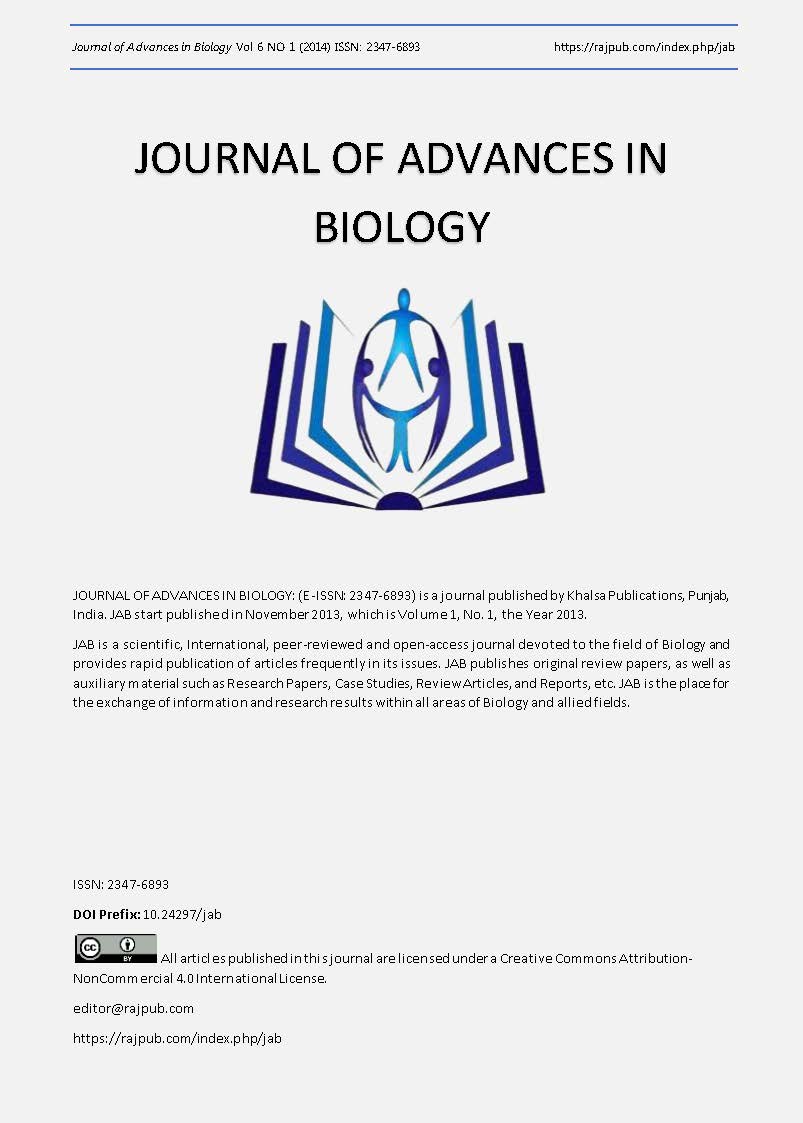Toxicological evaluation of chronic administration of Catharanthus roseus extract in the adult albino rats
DOI:
https://doi.org/10.24297/jab.v6i1.5464Keywords:
Catharanthus, Chronic use, ToxicityAbstract
Herbal drugs are common use in many developing countries because of its effectiveness and low cost. World Health Organization approved its use as treatment for many diseases. So it should study efficacy and safety the natural source of these drugs. Catharanthus roseus is a popular ornamental plant. It contains about seventy alkaloids and used for multiple therapeutic purposes. Available literature on Cathranthus indicated to controversial issue about its safety. This study evaluates toxicological effect the leaf extract of Catharantus roseus in the rats by assessment biochemical and histopathological changes of liver and kidney, morphological changes of pancreas and heart with study some hematological parameters. Sixty albino rats were divided into three groups, each group consists of twenty rats. Control group received water, while second and third group received 300 and 400mg/kg of leaf extract of Catharanthus roseus, respectively and daily by orogastric tube for three months. Prolonged use of Catharanthus roseus led to significant abnormalities of liver and renal function tests, and some hematological parameters associated with hepatic, renal, cardiac and pancreatic histopathological changes which increased based on the dose. Repeated use of Catharanthus roseus caused hepatic, renal, hematological, cardiac and pancreatic toxicity depending on the dose.Downloads
Download data is not yet available.
References
[1] Don G. Catharanthus roseus. In: Ross IA (ed). Medicinal plants of the World. Human Press, Totowa, New Jersey. 1999; pp 109-118. [2] WHO Traditional medicine strategy 2002-2003. WHO Publications. 2002; p 1-6. [3] Heijden RVD, Jacobs DI, Soneijer W, Hallard D and Verpoorte R. The Catharanthus Alkaloids.Pharmcognosy and Biotechnology. Current Medicinal Chemistry. 2004; 11(5). 607-628. [4] Loh KY. Know the medicinal herb. Catharanthus roseus (Vinca rosea). Malaysian Family Physician. 2008; 3 (2). 123. [5] James SA, Bilbiss L and Muhammad BY. The effects of Catharantus roseus aqueous leaf extract on some hematological indices as determined in rabbits. Chem. Class Journal. 2007; 4. 138-141. [6] Ahmad NH, Abdul Rahim R and Mat I. Catharanthus roseus Aqueous Extract is Cytotoxic to Jurkat Leukaemic T-cells but induces the Proliferation of Normal Peripheral Blood Mononuclear Cells. Tropical Life Sciences Researc. 2010; 21(2), 101–113. [7] Upmanyu R, Dvivedi J and Saxena Y. Hepatotoxic effect of vincristine: an experimental study on albino rats. Indian J Physiol Pharmacol; 2009; 53 (3): 265-270. [8] Alxeandrova R, Alxeandrova I, Velcheva M and Varadino T. Phytoproducts and cancer. Experimental Pathology and Parasitology. 2000; 4. 15-25. [9] Dufour DR, Lott JA, Gretch DR, Koff RS and Seeff LB. Diagnosis and monitoring of hepatic injury. Recommendations for laboratory test in screening, diagnosis and monitoring. Clin. Chem. 2000; 46. 2050-2068. [10] Doucete F. Sodium-potassiumadenosinetriphosphatase- dependent sodium transport in the kidney. Hormonal control. Physiol Rev. 2001; 81. 345-408. [11] Adekomi DA. Madagascar periwinkle (Catharanthus roseus) enhances kidney and liver functions in wistar rats. International journal of biomedical and health sciences. 2010; 6, 4.245-254. [12] Natarajan A, Ahmed KSZ, Sundaresan S and Kumar BS. Effect of aqueous flower extract of Catharanthus roseus on alloxan induced diabetes in male albino rats. IJPSDR. 2012; 4(2).150-153. [13] McKenzie M. Clinical Laboratory Hematology, 2nd ed., Prentice Hall, 2010; 411-422. [14] Chatterjee TK. Handbook of laboratory mice and rats .1st ed., K. Chatterjee Publisher, Calcutta, 1993; 3-8. [15] Daniel SP and Marshall MK. Evaluation of the liver. laboratory tests. Schiff’s diseases of the liver, 8th ed. USA, JB Lippincott publications. 1999; 205-239. [16] Bain PJ. Liver. In. Latimer KS, Mahaffey EA, Prasse KW (eds.). Duncan and Prasse’s Veterinary Laboratory Medicine. Clinical Pathology, 4th ed. Ames, Iowa State University Press, 2003; pp 193-214. [17] Alexander RH and Griffith JM. Clinical/Nutritional Biochemistry. Basic Biochemical Methods. 2nd ed., Wiley-Liss, New York. John Wiley & Sons, 1992;pp111-123. [18] Bancroft JD and Gamble M. Theory and Practice Histological Techniques, 5th ed., Churchill Livingstone. New York, Edinburgh and London, 2002; pp126 and 173-175. [19] Karthikeyan S, Abdul jaleel C and Iqbal M. Antibiogram of Catharanthus roseus extracts. Global Journal of Molecular Sciences. 2008; 3(1).1-7. [20] Sherlock S. Assessment of liver function Disease of liver and biliary system. Sheila Sherlock, 10th ed., London, Blackwell science ltd. 1997; 17-32. [21] Crawford JM. Liver and biliary tract, Pathological basis of diseases. Robins and Cotran, 7th ed. 2006; 77-938. [22] Pincus MR and Abraham NZ. Interpreting laboratory results. In. McPherson RA, Pincus MR, eds. Henry's Clinical Diagnosis and Management by Laboratory Methods. 21st ed. 2006; Philadelphia, Pa. Saunders Elsevier, chap 8. [23] Aragon G and Younossi ZM. When and how to evaluate mildly elevated liver enzymes in apparently healthy patients. Cleveland Clin. J. Med. 2010. 77(3). 195-204. [24] Kevin L, Hussin AH, Zhari I and Chin JH. Sub-acute oral toxicity study of methanol leaves extract of Catharanthus roseus in rats. Journal of Acute Disease. 2012; 38-41. [25] Upmanyu R, Dvivedi J and Saxena Y. Hepatotoxic effect of vincristine. An experimental study on albino rats. Indian J Physiol Pharmacol. 2009; 53 (3). 265-270. [26] Rasineni K, Bellamkonda R, Singareddy S and Desireddy S. Antihyperglycemic activity of Catharantus roseus leaf powder in streptozotocin –induced diabetic rats. Pharmacognosy Research, 2010; 2.3:195.
Downloads
Published
2014-10-22
How to Cite
Elshama, S. S., Osman, H.-E. H., & El-Kenawy, A. E.-M. (2014). Toxicological evaluation of chronic administration of Catharanthus roseus extract in the adult albino rats. JOURNAL OF ADVANCES IN BIOLOGY, 6(1), 817–824. https://doi.org/10.24297/jab.v6i1.5464
Issue
Section
Articles
License
 All articles published in Journal of Advances in Linguistics are licensed under a Creative Commons Attribution 4.0 International License.
All articles published in Journal of Advances in Linguistics are licensed under a Creative Commons Attribution 4.0 International License.




